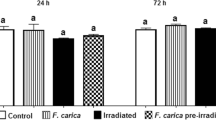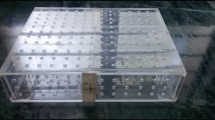Abstract
Date was considered a high nutritional value fruit due to its high content of active ingredients. Frequent exposure to cosmetic radiations including UVC caused deleterious effects and tissue damage and organ affection. This study investigated the efficacy of Ajwa date extract (ADE) in protection against UVC-induced kidney injury in rats. Five groups of rats were included in this study. Group I: Rats were exposed to UVC radiation at a dose 5 kJ (1 h/day) for 28 days. Group II: Rats were pretreated orally with ADE (10 mg/kg/day) 1 h before exposure to UVC radiation with dose 5 kJ. Group III: Rats were pretreated with ADE (15 mg/kg) 1 h before exposure to UVC radiation. Group IV: Rats were exposed to UVC radiation then treated with ADE (10 mg/kg). Group V: Rats exposed to UV radiation then treated with ADE (15 mg/kg) after 1 h from exposure. Analyzing the active constituents of ADE by GC/MS showed that, quercetin, myricetin kaempferol, thymine, and catechol are the most active ingredients. Biochemical markers obtained showed that, serum 8-oxoguanine as marker for DNA damage was increased, and total antioxidant activity and glutathione reduced were decreased (p < 0.01), while neutrophil (p < 0.001), conjugated diene (p < 0.05), and interferon-γ (p < 0.01) were increased after exposure to UVC. However, all the parameters changed were reversed by ADE-treated rats compared with untreated; the higher dose was more effective and protective effect was better than treated effect. Kidney total proteins and reduced glutathione and procollagen levels were decreased while malondialdehyde was increased after exposure to UVC (p < 0.01). These abnormalities were normalized by ADE treatment and protected. It was concluded that, flavonoids from Ajwa extract protected against deleterious effects of UVC by enhancing antioxidant activities and reducing infiltration of neutrophils that caused kidney injury.



Similar content being viewed by others
Data availability
All datasets generated or analyzed during this study are included in the manuscript.
References
Abdelaziz DH, Ali SA, Mostafa MM (2015) Phoenix dactylifera seeds ameliorate early diabetic complications in streptozotocin-induced diabetic rats. Pharm Biol 53(6):792–799
Ahmed AF, Al-Qahtani JH, Al-Yousef HM, Al-Said MS, Ashour AE et al (2015) Proanthocyanidin-rich date seed extract protects against chemically induced hepatorenal toxicity. J Med Food 18:280–289
Alam MN, Bristi NJ, Rafiquzzaman M (2013) Review on in vivo and in vitro methods evaluation of antioxidant activity. Saudi Pharm J 21(2):143–152
Al-Qarawi A, Abdel-Rahman H, Ali B, Mousa H, El-Mougy S (2005) The ameliorative effect of dates (Phoenix dactylifera L.) on ethanol-induced gastric ulcer in rats. Journal of Ethnopharmacology. 98(3):313–7.
Al-Qarawi AA, Abdel-Rahman H, Mousa HM, Ali BH, El-Mougy SA (2008) Nephroprotective action of Phoenix dactylifera ingentamicin induced nephrotoxicity. Pharm Biol 46:227–230
El Abed H, Chakroun M, Abdelkafi-Koubaa Z, Drira N, Marrakchi N, Mejdoub H, Khemakhem B (2018) Antioxidant, antiinflammatory, and antitumoral effects of aqueous ethanolic extract from (Phoenix dactylifera) L. parthenocarpic dates. Biomed Res. Int. 2018, 1542602.
García ER, Gutierrez EA, Melo F C, Novaes RD, Gonçalves RV (2018) Flavonoids effects on hepatocellular carcinoma in murine models: a systematic review. Evidence-Based Complementary and Alternative Medicine, 1–23.
Hamad I, AbdElgawad H, Al Jaouni S, Zinta G, Asard H, Hassan S, Hegab M, Hagagy N, Selim S (2015) Metabolic analysis of various date palm fruit (Phoenix dactylifera L.) cultivars from Saudi Arabia to assess their nutritional quality. Molecules 20:13620–13641
Hussain MI, Semreen MH, Shanableh A, Khattak MNK, Saadoun I, Ahmady IM, Mousa M, Darwish N, Radeef W, Soliman SS (2019) Phenolic composition and antimicrobial activity of different Emirati date (Phoenix dactylifera L.) pits: a comparative study. Plants, 8, 497.
Idowu AT, Igiehon OO, Adekoya AE, Idowu S (2020) Dates palm fruits: a review of their nutritional components, bioactivities and functional food applications. AIMS Agric Food 5:734–755
Jagetia GC, Reddy TK (2005) Modulation of radiation-induced alteration in the antioxidant status of mice by naringin. Life Sci 77(7):780–794
Jariashvili K, Madhan B, Brodsky B, Kuchava A, Namicheishvili L, Metreveli N (2012) UV damage of collagen: insights from model collagen peptides. Biopolymers 97:189–198
Krishnaveni M, Dhanalakshmi R, Nandhini N (2014) GC-MS analysis of phytochemicals, fatty acid profile, antimicrobial activity of Gossypium seeds, Int. J. Pharm. Sci. Rev. Res., 27(1). Article No 49:273–276
Madrazo A A, Churg J (1976) Radiation nephritis. Chronic changes following moderate doses of radiation. Laboratory Investigation; a Journal of Technical Methods and Pathology. 34(3): 283–290.
Mohamed SA, Awad MA, El-Dengawy ERF, Abdel-Mageed HM, El-Badry MO, Salah HA, Abdelaty AM, Fahmy AS (2016) Total phenolic and flavonoid contents and antioxidant activities of sixteen commercial date cultivars grown in Saudi Arabia. RSC Adv 6:44814–44819
Moon JK, Shibamoto T (2009) (2009) Antioxidant assays for plant and food components. J Agric Food Chem 57(5):1655–1666
Mrabet A, Rodriguez-Arcos R, Guillen-Bejarano R, Chaira N, Ferchichi A and Jimenez-Araujo A (2012). Dietary fiber form Tunisian common date cultivars (Phoenix dactylifera L.): chemical composition, functional properties and antioxidant capacity. J. Agri. Food Chem., 60(14): 3658–3664.
Olinski R, Rozalski R, Gackowski D, Foksinski M, Siomek A, and Cooke M Urinary (2006) measurement of 8-oxodg, 8-oxogua, and 5hmura: a noninvasive assessment of oxidative damage to DNA antioxidants & redox signaling, Volume 8, Numbers 5 & 6.
Panche AN, Diwan AD, Flavonoids CSR (2016) an overview. J Nutr Sci 5:e47
Rahman I, Kode A, Biswas SK (2006) Assay for quantitative determination of glutathione and glutathione disulfide levels using enzymatic recycling method. Nat Protoc 1(6):3159–3165
Rahmani AH, Aly SM, Ali H, Babiker AY, Srikar S, Khan AA (2014) Therapeutic effects of date fruits (Phoenix dactylifera) in the prevention of diseases via modulation of anti-inflammatory, anti-oxidant and anti-tumour activity. Int J Clin Exp Med 7:483–491
Rabotyagova OS, Cebe P, Kaplan DL (2008) Collagen structural hierarchy and susceptibility to degradation by ultraviolet radiation. Mater Sci Eng C Mater Biol Appl 28:1420–1429
Riley PA (2009) Free radicals in biology: oxidative stress and the effects of ionising radiation. Int J Radiat Biol 65(1):27–33
Saafi EB, Louedi M, Elfeki A, Zakhama A, Najjar MF, Hammami M and Achour L (2011). Protective effect of date palm fruit extract (Phoenix dactylifera L.) on dimethoate induced oxidative stress in rat liver. Exp. Toxicol. Pathol., 65(5): 433–441.
Takahashi T, Hato F, Yamane T, Fukumasu H, Suzuki K, Ogita S, Nishizawa Y, Kitagawa S (2001) Activation of Human Neutrophil by Cytokine-Activated. Endothelial Cells Circ Res 88:422–429
Vayalil PK (2002). Antioxidant and antimutagenic properties of aqueous extract of date fruit (Phoenix dactylifera L. Arecaceae). J. Agri. Food and Chem., 50(3): 610–617.
Acknowledgements
This project was funded by the Deanship of Scientific Research (DSR), King Abdulaziz University, Jeddah, Under grand no. (KEP-PhD-6-130-41). The authors therefore, acknowledge with thanks DSR for technical and financial support.
Author information
Authors and Affiliations
Contributions
TAK, SSM, and KOA design protocol, AMKM running experiments, KK and MQ and SM analyzed data and interpretations. All authors revise the manuscript and approve it.
Corresponding author
Ethics declarations
Ethical approval.
The study protocol was approved by the Ethics Committee of King Abdulaziz University Hospital, Jeddah, Saudi Arabia. The protocol was done according to the ethical guidelines of the 1975 Declaration of Helsinki.
Consent to participate
Not applicable.
Consent for publication
Not applicable.
Conflict of interest
The authors declare no competing interests.
Additional information
Responsible Editor: Lotfi Aleya
Publisher's Note
Springer Nature remains neutral with regard to jurisdictional claims in published maps and institutional affiliations.
Rights and permissions
About this article
Cite this article
Abulnaja, K.O., Kannan, K., Al-Manzlawi, A.M.K. et al. Ajwa date flavonoids mitigate neutrophil migration and interferon-γ-induced renal injury by ultraviolet C radiation in rats. Environ Sci Pollut Res 29, 71607–71613 (2022). https://doi.org/10.1007/s11356-022-20956-x
Received:
Accepted:
Published:
Issue Date:
DOI: https://doi.org/10.1007/s11356-022-20956-x




